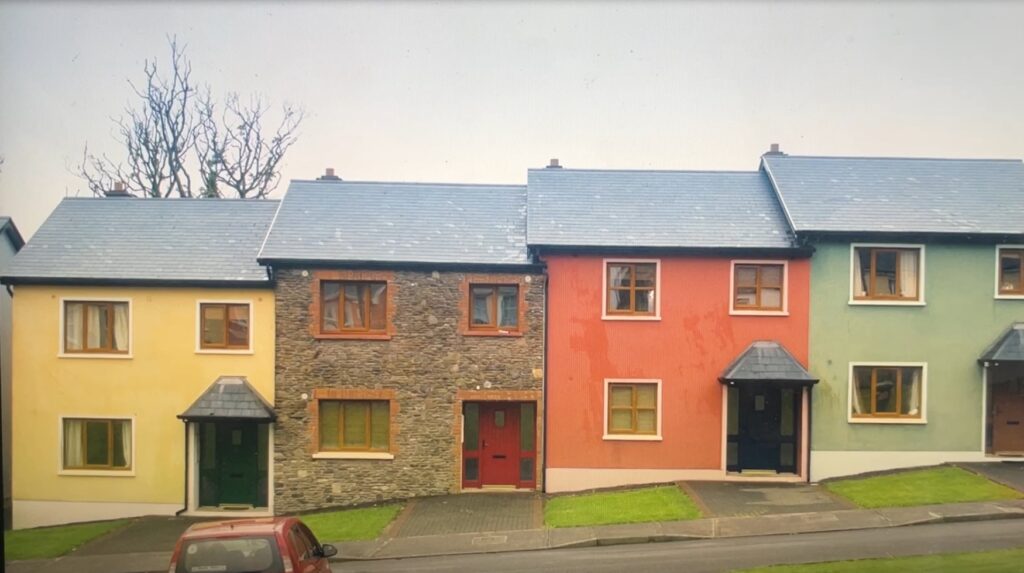Run and Jump - Dingle
Daingean Uí Chúis
|
Dingle
Address
Fearann na Cille, Daingean Uí Chúis, Corca Dhuibhne
52.143596
, -10.273475

These colourful houses are typical of the architecture of Dingle, which served as the backdrop for the urban locations in this film. Several scenes are set in the town, although it is renamed as the fictional Banamore in the film. Although many films were made in the Dingle Peninsula, few feature the eponymous town itself.
Run & Jump is the first of a sort of “West Kerry mothers” trilogy, followed by Joyride in 2021 and completed by Tarrac in 2023: three films, all shot in West Kerry, all focusing on different types, stages, and experiences of motherhood, all consciously or not focused on rebalancing Irish cinema’s (much like all of the rest of cinema’s) male-centric bias. Typically, even when relatively recent Irish films have been “about” a mother’s experience, like The Snapper from 1993 or In America from 2003, the film has really been about how her experience of pregnancy and/or parenting impacts a male member of her family, ultimately forcing his emotional maturation. Thus, Des Curley, Sharon’s father in The Snapper, learns how to be a better, more sympathetic father and husband through Sharon’s falling pregnant; and grieving father Johnny learns how to really feel his feelings about the death of his young son Frankie through the trauma of his wife’s latest experience of childbirth in In America. The pattern is such that, really, any Irish film about motherhood is also, or really is, about fatherhood.
Run & Jump flips the script: it is a film about fatherhood that is actually about motherhood (and, like Joyride, is written by West Kerry native Ailbhe Keoghan). The film lands us, in medias res, into the lives of a nuclear Irish family: mother Vanetia (English actress Maxine Peake taking a stab at an Irish accent), father Conor, son Lenny, and daughter Noni. But also there is doctor Ted Fielding (American actor Will Forte very much staying in his lane, accent-wise). Dr Fielding has been awarded a grant to study, via meticulous video recordings, Conor’s continued rehabilitation and re-entry into domestic life following a catastrophic stroke that left him childlike and unable to perform his fatherly and partnerly duties in the usual way. Part of the film’s project is to show us/Vanetia that fatherhood and partnerhood can look “different” to what we, the audience, are used to, vis-a-vis Vanetia’s learning to let go of her own expectations of masculinity, to grieve the partner she lost, and to accept and love the man he has become.
The function of Dr Fielding – in addition to being a rival, and ultimately rejected, love interest for Vanetia – is to allow a voyeuristic perspective on her from within the world of the film and through his eyes. Increasingly, we see that Dr Fielding’s video recordings are of Vanetia, as opposed to Conor himself. Dr Fielding is recording Vanetia’s reactions to the situation in which she finds herself, more so than Conor’s independent actions and reactions to his own condition. So, Vanetia, this mother in and of Irish Cinema, does not escape objectification under the male gaze, but she does steal a good deal of subjectivity away from Conor in Dr Fielding’s film-world-within-the film-world. This is symptomatic of a broader balancing of scales regarding gendered perspective in Irish Cinema in the 21st century, even if Vanetia’s increasing centrality within the film frame is also an indication of Dr Fielding’s gaining subjective perspective and importance.
Run & Jump ends with a series of lingering looks after each of the family members takes a dip (or metaphorical re-bapstism) in the sea off Duinín Pier, on the north side of the Dingle Peninsula: Vanetia looks at Conor; Vanetia and Dr Fielding look at each other; Vanetia and Conor separately look out towards the landscape of West Kerry (the last image we see is of the Blasket Islands off the coast of Dunquin). It is the first time in the world of the film in which the landscape, heretofore lingering in the background or corners of the frame and establishing shots, is centered. The meaning is clear: each family member who has had to renegotiate their familial role due to circumstance, orientation, and/or trauma (which is also every family member, including Dr Fielding), has arrived at virgin territory, wherein and whereby traditional gender roles need not apply, dictate experience, or write definitive endings.
In the video below, screenwriter Ailbhe Keoghan discusses her relationship with Corca Dhuibhne, and what inspired her in creating scripts based in this region.

